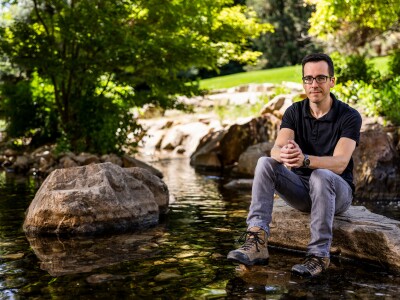Brigham Young University owes its heritage to many remarkable teachers and scholars beginning with the considerable contributions of Karl Gottfried Maeser. The master teacher’s inspired guidance in the school’s critical founding years continues to illuminate and inspire the university today, more than a century after his death.
BYU will honor the early leader in September when it recognizes him as the university’s Founder during Homecoming 2007. The Homecoming theme, “Come Full Circle,” is open to many interpretations — getting an education, making a mark and returning to BYU, for example, or the idea of Maeser’s integrity.
He is quoted as saying, “I have been asked what I mean by ‘word of honor.’ I will tell you. Place me behind prison walls — walls of stone ever so high, ever so thick, reaching ever so far into the ground — there is a possibility that in some way or another I may escape; but stand me on the floor and draw a chalk line around me and have me give my word of honor never to cross it. Can I get out of that circle? No. Never! I'd die first.”
Educated in Germany, Maeser converted to The Church of Jesus Christ of Latter-day Saints and immigrated to Utah shortly before the U.S. Civil War. Several years later, in 1876, Brigham Young appointed Maeser as principal of Brigham Young Academy with the admonition that he should not teach even the alphabet or the multiplication table without the Spirit of God.
Maeser would later say as the speaker at Brigham Young Academy’s first Founder’s Day exercises Oct. 16, 1891, that he had “no comprehension of the magnitude of the work” to come when President Young laid out the plans for his new mission. He added, however, that he never wavered from his conviction that the academy was a divinely-inspired school of destiny.
When he arrived in Provo, Maeser faced some sobering challenges. The town was largely apathetic toward the fledgling school, enrollment was small — a mere 29 students — and he was the only instructor. He would spend the next 15 years in abject poverty with inadequate premises, limited facilities, and even open opposition from some community leaders who lacked confidence in the new institution.
Academy headquarters in the Lewis Building on West Center Street were less than ideal. Funding was scant, the cellar leaked and the principal’s office lacked furniture. (The situation became critical when the building burned in 1884.) Despite adversity, Maeser persevered to establish the Academy curriculum, grading and schedules — which had been in a state of disarray — and they became increasingly ordered and academically sound.
He said, “If amidst all these changing scenes clouds of discouragement did occasionally darken the horizon of our vision, they were always dispelled by the voice of the Spirit whispering, ‘O ye of little faith.’”
During one of the academy’s financial crises, he decided to accept a position at the University of Deseret in Salt Lake City. His wife and daughter prepared to leave and were sitting on their trunks when the daughter finally mustered enough courage to ask her father when they were leaving. He said, “I have changed my mind. I have had a dream — I have seen Temple Hill [present site of campus] filled with buildings — great temples of learning, and I have decided to remain and do my part in contributing to the fulfillment of that dream.”
And he did. Maeser is often cited as the spiritual architect of Brigham Young University and Brigham Young Academy. It has been said that what Brigham Young did for the settlement of the West, Karl Maeser did for education in the West. He stayed at BYA until 1892 when he accepted an assignment as general superintendent of Church schools in Salt Lake City and assistant superintendent of Sunday Schools in the Church.
Just two months before his death in 1901, he returned to BYU and spent a few minutes in one of the classrooms. He had become famous for his sayings, and while there, he wrote four short thoughts on the chalkboard, perhaps as a final message to the students.
They are as applicable today as they were then.
“The fear of God is the beginning of all wisdom.”
“This life is one great assignment, and that is to become absorbed with the principles of immortality and eternal life.”
“Man grows only with his higher goals.”
“Never let anything impure enter here.”
After Maeser’s Feb. 15, 1901 death, students, colleagues and alumni were determined to honor their beloved teacher in a lasting way with a memorial that became the first permanent university building on upper campus — and the first of the temples of learning Maeser had envisioned.
Since the completion of the graceful, classic structure in 1910, the Maeser Building has served thousands of students, is the home for the Honors Program. The building is a permanent reminder to a man whose mission was to save souls, mold characters and teach eternal truths.
Writer: Charlene Winters





